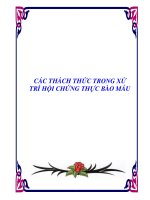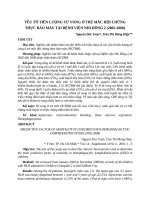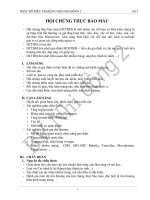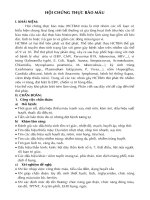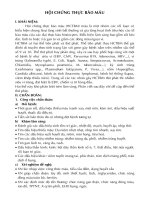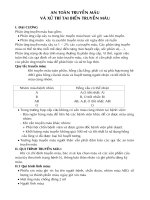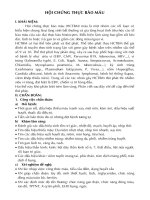Hội chứng thực bào máu
Bạn đang xem bản rút gọn của tài liệu. Xem và tải ngay bản đầy đủ của tài liệu tại đây (5.33 MB, 32 trang )
HỘI CHỨNG THỰC BÀO
MÁU.
(HEMOPHAGOCYTIC LYMPHOHISTOCYTOSIS
)
#
INTRODUTION.
• An aggressive and life-threatening syndrome of
excessive immune activation.
• Was described in 1952.
• Most frequently affects infants
( from birth to 18 months of age)
but also observed in children and adults of all ages.
• Familial or sporadic disorder.
#
EPIDEMIOLOGY
• 1/50,000 live births.
• 1/3000 inpatient admissions to tertiary care hospitals.
• Infants are most commonly affected
the highest incidence in those <3 months
• Male:Female is 1:1 .
• 25 % of HLH cases are familial.
• Mutations in STX11, PRF1, and UNC13D were found
in 20, 1.8, and 10 percent of affected individuals.
#
#
#
#
#
#
#
#
CLINICAL PRESENTATION
• Likely to be diagnosed more often in
infants
• Clinical condition is not severely
impaired initially
• Anemia/thrombocytopenia is usually
present
• Patients may improve with non-specific
therapies such as transfusions or
#
antibiotics, but responses are usually
CLINICAL PRESENTATION
• Fever is uncommon in neonates
• HSV/EV
• Can be easily missed and mismanaged
as sepsis
#
CLINICAL PRESENTATION
• Neurologic involvement is seen in 3050%
• Seizures, altered mental status, brain
stem symptoms, and ataxia
• Atypical presentation:
– Colitis
– Bleeding disorder
– Hypogammaglobulinemia
#
NATURAL HISTORY
#
Large T cell lymphoma with reactive hemophagocytosis
The red pulp of the spleen is diffusely permeated by large lymphoma cells (T
lineage, blue arrows) and histiocytes showing erythrophagocytosis (black
arrow). The histiocytes have smaller, bland-looking nuclei with delicate
chromatin.
#
Infection-associated hemophagocytic syndrome
Bone marrow from a child with hemophagocytic syndrome, secondary to Epstein-Barr
virus infection. Reactive histiocytes show phagocytosis of nucleated red blood cells (red
arrows) and platelets (black arrows). Wright-Giemsa stain.
#
EBV - HLH
#
EBV - HLH
• 78 pts
• No genetic testing was done
• Group 1: 33 received (gancyclovir
or/and interferon) and immunotherapy
(steroid and IVIG)
• Group 2: 45 received HLH 94 protocol
• Treatment group was decided by
physician
#
#
EBV - HLH
• Conclusion
– EBV-specific therapy using aciclovir or ganciclovir
did not improve the survival rate and neither did
conventional immunomodulatory therapy
(corticosteroids and immunoglobin infusion)
– Chemotherapy (HLH-94 or HLH-04) yielded better
results than non-chemotherapy treatments (40%
vs 84%)
– The high fatality of our patients in the
chemotherapy group can be attributed to the lack
of early etoposide-based chemotherapy, as well
as delayed diagnosis
#
EBV - HLH
#
EBV - HLH
• Acyclovir does not appear to be useful
in the treatment of EBV-associated
HLH*
• Adenovirus – vidarabine
• HHV-8 -- foscarnet
* CDC website – Hemophagocytic syndromes and infection
#
#
• 47 Patients with EBV-HLH
• Group 1: 21 pts were treated first with steroid
alone/IVIG alone/CSA alone/combination
17 pts were switched to etoposide containing
regimens
4 did not receive etoposide (one recovered, 3
died)
• Group 2: 26 pts were treated with etoposide
containing regimens
#
#
